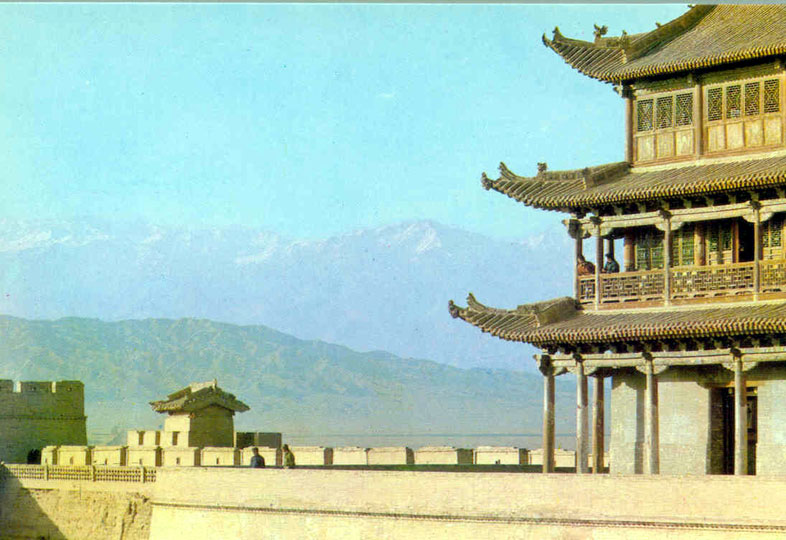
From the Silk
Road to the Great Game:
China, Russia, and Central Eurasia
| Fall 2001 | Peter C. Perdue |
| MW 2:30 - 4 | E51-291, x3064 |
| Room 1-246 | pcperdue@mit.edu |
Course Locker Address: http://web.mit.edu/21h.580/www
This subject examines interactions across the Eurasian continent between Russians, Chinese, Mongolian nomads, and Turkic oasis dwellers during the last millenium and a half. As empires rose and fell, religions, trade, and war flowed back and forth continuously across this vast space. Today, the fall of the Soviet Union and China's reforms have opened up new opportunities for cultural interaction. Topics include the religious traditions of Central Asian Islam, Buddhism, Christianity, and Confucianism; caravans and travellers, like Marco Polo and Rabban Sauma [the first Chinese to travel to the West]; nomadic conquest and imperialist competition, past and present. Source materials include primary documents, travelogues, films, music, and museum visits.
COURSE REQUIRMENTS
This will be a lecture and discussion course. Come to class having done the reading for the week, and be prepared to discuss questions raised in the reading and lectures. There will be one hour exam at midterm, with a map quiz, ID questions, and a short essay. One 10-15 page paper due BEFORE the last class. This can be a discussion of a travel account, an art exhibit, political relations, or on a topic of your choice. I will give suggested topics and bibliography during the term. There is NO Final Exam
READINGS
Barfield, Thomas, The Perilous Frontier
Bonavia, Judy, The Silk Road
Daniel R. Brower, Edward Lazzerini, eds., Russia's Orient: Imperial
Borderlands and Peoples, 1700-1917
Foltz, Richard C. Religions of the Silk Road
Peter Hopkirk, The Great Game: The Struggle for Empire in Central Asia
Kipling, Rudyard Kim Liu, Xinru, The Silk Road: Overland Trade and
Cultural Interaction
Polo, Marco The Book of Marco Polo
Rossabi, Morris Khubilai Khan: His Life and Times
Whitfield, Susan, Life along the Silk Road
Reader with articles available at Hayden Reserve:
- Maps of Central Eurasia
- Victor H. Mair, "Mummies of the Tarim Basin",Archaeology, 1995, vol.48, no.2, p. 28-35
- David Anthony, Dimitri Y. Telegin, Dorcas Brown. "The origin of horseback riding" . Scientific American vol. 265 no.6, December 1991.
- David W. Anthony, Nikolai B. Vinogradov. "Birth of the Chariot."Archaeology 1995 March-April , 36-41.
- David W. Anthony, "Shards of Speech".The Sciences, 1996.
- Herrlee G. Creel, "The Role of the Horse in Chinese History", in Creel, What is Taoism: and Other Studies in Chinese Cultural History, p.160-186. Chicago, 1970
- Peter C. Perdue, "The Economy of the Silk Road"
- Victor H. Mair, "Dunhuang as a Funnel for Central Asian Nomads into China", in Gary Seaman, ed., Ecology and Empire:Nomads in the Cultural Evolution of the Old World, 143-163
- Joseph Fletcher. "The Mongols: Ecological and Social Perspectives." Harvard Journal of Asiatic Studies, June 1986, p. 11-50
- Morris Rossabi, "The "Decline" of the Central Asian Caravan Trade", in Gary Seaman, ed., Ecology and Empire:Nomads in the Cultural Evolution of the Old World p.81-102.
- Sep. 5 Big Questions: World Systems and Civilizations; The Pivotal Role of Central Eurasia. READING: Study Maps in Reader
- Sep. 10 ,12 Corpses and Chariots: Mummies, Horses and the rise of Nomadism READING: Articles #2,3,4,5 in reader (Mair, Anthony, et.al); Barfield p. 1-31 Sep. 17 HOLIDAY: NO CLASS
- Sep. 19, 24 The Rise of the Silk Route Trade; Han, Xiongnu, and Roman Empires READING: Liu Xinru; Articles #6, 7 in Reader (Creel and Perdue); Barfield 33-80
- Sep. 26, Oct. 1 Religions along the Silk Routes: Islam, Christianity, Manicheanism, Judaism, Buddhism. READING: Foltz
- 3 I will be out of town, but there will be a film shown during class time. It is NOT optional: You will have to write a 1-2 page commentary on it. Oct. 8. HOLIDAY: NO CLASS
- Oct. 10, 15 Cave Paintings and Sculpture: Dunhuang and others READING: Whitfield; Article #8 (Mair) in reader; Barfield 131-163
- Oct. 17, 22 Caravans and Conquest: Marco Polo, Rabban Sauma, and Kublai Khan READING: Article #9 (Fletcher) in Reader; Marco Polo; Rossabi
- Oct. 24 Ming China and the Rise of Muscovy READING:Barfield 229-65; Article #10 in reader (Rossabi); Chapter 1 in Brower & Lazzerini (Khodarkovsky) Oct. 29 MIDTERM EXAM
- Oct. 31, Nov. 5 Manchu conquest of Central Asia, Russian and Mongolian negotiations READING: Barfield 266-303; Chapter 2 in Brower & Lazzerini (Slezkine)
- Nov. 7 Tibet and Xinjiang's Role in Central Asian Politics READING: Bonavia Nov. 12 HOLIDAY: NO CLASS
- Nov. 14, 19 The Nineteenth Century Great Game: Britain, Russia, and China READING: Hopkirk; Chapters 6 (Brower) and 14 (Grant) in Brower and Lazzerini; Kipling
- Nov. 21 Twentieth Century Explorers and Looters: Aurel Stein, et.al. READING: TBA
- Nov. 26, 28 Soviet and Chinese revolutions READING: TBA
- Dec. 3, 5 Post-Soviet developments in Central Asia and Xinjiang READING: TBA FINAL PAPER DUE
- Dec. 10, 12 Intercultural Contacts from Amsterdam to Japan: Yo-yo Ma and the Silk Road Project; The Dalai Lama in the Modern World; Richard Feynman "goes" to Tuva. READING: TBA
Please send questions and comments to helenjt@mit.edu.
Last update: November 14, 2001